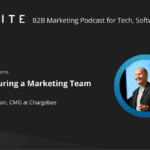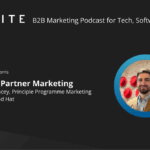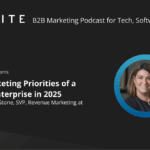At FINITE, we ask the questions that other B2B marketers are curious to know, yet are sometimes afraid to ask within their peer group. We talk automation, pain-points, data and when to focus on which aspect of your marketing mix, plus many more insights like this. Every month we aim to ask a Senior Marketer in the B2B Technology space the questions you may have been asking yourself. Today, we talk to Harry Lancaster, Head of Marketing at Bibblio, a unique proposition, in that it is a content recommendation tool that promotes content of relevance to what you’ve been reading. Not to be confused with some of the big name Ad-Tech solutions…
How did you get into marketing, to begin with?
My story is quite a ‘startup’ one, meaning that my marketing role evolved out of a pretty different situation! I started with Bibblio doing business development, having come directly from being a corporate lawyer. After a year at Bibblio, it became clear that we needed someone to take on marketing more than we needed an extra body doing business development, so I volunteered, and here I am 18 months later
What advice would you give to someone wanting to work in marketing the B2B technology sector?
Marketing for a startup is predominantly about experimentation and data: find a channel, test it, analyze results, tweak. You start with a blank slate, not much of a budget, and to begin with, it’s unlikely to even be clear which channel to try. Peter Thiel said that if you can get even a single distribution channel to work, you have a great business, and your role as a startup marketer is to find it. It can be daunting, but also exciting and very satisfying. You can’t hide though, and you need to thrive on the challenge of making it happen yourself.
With B2B technology marketing, the key challenge is often understanding the product well enough to target the right message to the right person in a possible client. Great copy aimed at a CEO in a tech-first company might be ineffective if the CTO has a veto and they don’t like your pitch. “There’s no way we can find space for that on the roadmap” is a quick and lethal conversion killer.
What do you see as being the major opportunity in the marketplace for Bibblio?
Something we’re increasingly thinking about is how Bibblio and native content fit together. Bibblio shows users relevant, ad-free content from a client’s site through modules on their pages (think if Outbrain had no ads and spam, only relevant content). We’ve marketed this as a way to raise engagement – it keeps audiences on-site for longer, viewing more pages – but I’m increasingly thinking that a big benefit to sites would be using Bibblio as a way to surface native advertising in consistently relevant places. It should really help to increase engaged viewing of native content. That’s one angle we’re exploring.
The other place we’re concentrating is on our new ‘Syndicate’ project, which is going to use the module technology we already have to distribute ad-free recommended content between premium publishers who qualify for our network. The aim here is to share relevant audiences between publishers, who will get revenue from including ‘syndicated’ content from partners on their pages and can pay to ‘syndicate’ their own to those same partners.
I think this is going to appeal to a lot to audience acquisition teams at digital publishers, as they’re currently funnelling a lot of money towards Facebook and other social channels to acquire audiences who are, frankly, rubbish, a lot of the time. Getting visitors from similar content on neighbour sites locks in the relevance, and will avoid the multi-layered arbitrage and opacity of the current ad-tech tools that nominally do this. Watch this space!
Great copy aimed at a CEO in a tech-first company might be ineffective if the CTO has a veto and they don’t like your pitch. “There’s no way we can find space for that on the roadmap” is a quick and lethal conversion killer.
As a smarter content recommendation tool, how does content marketing form a part of your marketing strategy?
Yes, there’s an interesting circularity to the fact that we use content to market a product that’s all about making content more discoverable… Education for us is vital, as we’re entering a space where people already have a lot of associations with ‘content recommendation’, and it’s not easy to shift those. So we’ve created quite a lot of content to explain our place in the ecosystem, but the challenge, which I think is the same for everyone these days, is getting attention and cut through.
Do you invest in high-value longer form content as part of your marketing strategy?
Absolutely – we’re working on some stuff at the moment as part of the launch of a new product. I tend to agree with the idea that content needs to be either short enough to get the takeaways almost at a glance or genuinely long-form and adding a lot of value and insight. There’s no in-between. Showing that you really understand a problem space via a well researched long-form article is usually a powerful way of building credibility with potential clients.
How do events form a part of your marketing strategy?
We think events are going to be a really interesting channel for us to reach stakeholders who can become leads or advocates for our product. That’s partly because our market, premium digital publishers, is quite concentrated, both geographically and in terms of size. When done right, events are a powerful combination of human contact and value-add. We’ve got our own events in London, Berlin and New York, and since starting in earnest at the beginning of this year they’re really growing. We’re now seeing some great results in terms of leads and ROI.
Video marketing and interactive content continues to rise in popularity – how do you use video?
Video is something that we’re just getting into – we expect that it’s going to be integral to the launch of our new product. I think you need to think carefully about what you’re trying to achieve with it, though. We’re investing in video because we want to be able to tell an impactful story, and I think that video is the most effective way to do that with time-poor audiences (which is pretty much all audiences these days). However, I think it’s also getting more popular because it’s simply a more effective way to disrupt people’s attention and win a few seconds from them. I don’t think that can make up for not having top-notch content though.
Voice search seems to be a hot topic at the moment – how do you see it forming a part of your marketing or even a part of your product?
We’re not planning on using voice in our marketing in the foreseeable future, but that’s always open to revision. As a content recommendation service, I can see a world where voice search becomes important to us, but we’re not there yet, and as a startup, we can’t afford to spread ourselves too thinly.
The marketing world is becoming ever more driven by data, how does this impact your strategy?
As someone who only came into marketing in the last couple of years, everything I’ve done has always been viewed through the prism of data. This is doubly true because we’re a startup, and if a strategy isn’t producing measurable results in terms of leads etc. it’s very hard to justify.
The tools and technology in the marketing sector change quickly, how do you keep up?
I think the key is not to try and follow everything – work out what technology you need to complement your own strategies and make sure you’re aware of what’s going on in that space. At this point, most of what I see is an incremental improvement rather than a game-changer, and you’re likely to hear about those in any case.
Which marketing technology tools do you use at Bibblio?
We’re still quite early in terms of building our marketing stack. We use Hubspot CMS, which we’ve found a good solution to a lot of analytics, inbound optimisation etc., but beyond that, we’re really still testing a number of things. I’ll let you know if anything is worth an endorsement!










